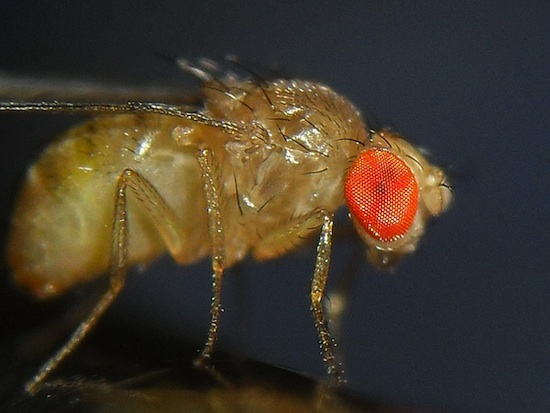Superfly: Science Engineers Fruit Flies That Produce Synthetic Proteins
Researchers in the United Kingdom have engineered fruit flies to produce synthetic proteins built in a lab. While the proteins don’t give the flies any superpowers as of yet, the experiment opens the door to the prospect of creating beneficial proteins down the line that could improve the health and longevity of the insects. Building on work done on simple nematode worms last year, researchers at the Medical Research Council Laboratory of Molecular Biology inserted DNA codons that contain instructions on how to make a home brewed protein of their own invention into the DNA of a fruit fly. That all means that we are basically a couple of years of research and one horrific family tragedy away from Spider-Man being a real thing. The time has come for rejoicing.
By inserting series of codons — three letter segments of DNA — into the fruit flies, scientists were able to start the insects producing their synthetic proteins. Those proteins were not only created, but incorporated into the flies’ cells, where they pretty much did nothing. When your goal is to make a creature produce foreign, invented proteins and incorporate them into its body, though, just having them do nothing is a victory compared to the other option. The other option being “kill that creature stone dead.”
Yes, fruit flies are not all that complicated when compared to humans. They can’t cook or sing or make compelling reality television, but when compared to nematode worms, fruit flies are incredibly complex, with a substantially larger genome and more complex physiology. They are also some of the most common and best understood lab animals in the world, and among the earliest test cases for major steps forward in genetics. The fruit fly (drosophila melanogaster if you’re nasty) was among the first animals in the world to have its genome fully sequenced — a full three years before the human genome was similarly decoded.
The news that fruit fly DNA can be tweaked to produce unheard of proteins with no ill effects could have pretty sweeping implications in the world of genetic engineering. While transgenic plants and animals have been around in laboratories and on dinner plates for years, building custom proteins — much less animals that can synthesize them — is still in its infancy as a field. It also begs some pretty scary questions about things like species identity. How far can you change a fruit fly until it’s not a fruit fly anymore? But like any potentially scary scientific development, it is also really awesome.
Pulling a gene from a salmon and putting in a tomato is a neat trick to be able to pull off, but the brass ring is not to have to depend on extant genes at all, but to build all-new DNA to suit every situation. Need a skin that doesn’t bruise on your peach or a banana peel that opens along a seam? Just build the instructions right into the organism. Want a Komodo dragon that produces flammable saliva? You almost certainly don’t, because that is a terrible, nightmarish idea, but it’s not one that is off the table. It’s certainly not on the table right now, either, but it’s a big table and we can’t see most of it.
Perhaps the most impressive part is the apparent safety and staying power of the introduced codons. The lab-engineered DNA segments were found to have no adverse health effects. Despite producing totally alien proteins and incorporating those proteins into their cells, the flies remained hale and hearty. So hale and hearty, in fact, that they even got the chance to breed, passing on their DNA to offspring. Those offspring had the same codons as their ancestors, and produce the same proteins — again, with no ill effects.
It would be irresponsible not to point out that, while this is super cool, it’s a long way off from any practical application in worms or lab mice, much less human beings. That said, if anyone at the Medical Research Council is reading this, I have always wanted laser eyes. Please make a note of it.
(via New Scientist)
- We want a battle royal between genetically enhanced fruit flies and artificial bacteria
- The coming generation of human-animal hybrids are illegal in Arizona, but what’s not?
- Now if only we could cure fruit flies crippling alcoholism
Have a tip we should know? [email protected]
